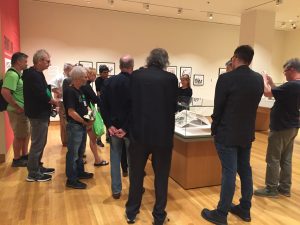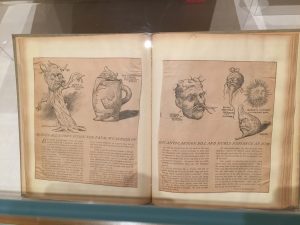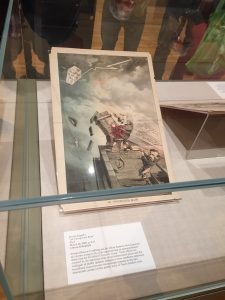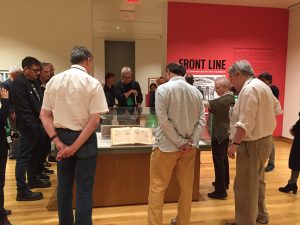After devoting myself to editorial cartooning at a rapidly increasing pace since the end of 2016, following the work of several cartoonists to the point of being able to identify a new cartoon’s artist without looking, and recording my reflections on the current state of the whole enterprise from an outsider’s perspective, I decided that maybe it was time to become an insider.
So in mid-August, anticipating the upcoming AAEC (Association of American Editorial Cartoonists) meeting in Columbus, Ohio, coinciding with CXC (Cartoons Crossroads Columbus), I submitted a membership application. Honestly, I didn’t know if it would be accepted considering that in spite of sending out the occasional pitch, I’m currently only published on my own site (this one), Patreon, and the various social media sites where I post my stuff.
But as it turns out, I was accepted. I would’ve attended the meeting even as a non-member, but it certainly helped to have membership established beforehand. It also helped tremendously that I received a job offer here in Wichita shortly before the trip, having spent several months unemployed. So I no longer had that hanging over my head and could make the trip with a lighter heart, although unfortunately with quite a light wallet as well.
I’ve attended multiple cons without knowing anyone very well beforehand, so in spite of my intense social anxiety, that part didn’t bother me so much. What bothered me was the possibility of not being heard– the chance that I might self-sabotage a very important networking opportunity, an opportunity for discussion, for being “with your own kind” in the way that people who attend cons much more frequently like to put it, by being too shy to meaningfully interact with anyone.
Turns out I needn’t have worried.

Although I didn’t actually interact with any cartoonists on the first day– and that was my fault. Since I had to be at the airport at about 3:30am for my 5:50am flight to Columbus from Wichita on the 26th, I’d opted to stay up the entire night beforehand, and so was basically running on fumes by the time of arrival at the Holiday Inn in downtown Columbus. As it happens, the designated locale for the first events that evening was also about a 30 minute walk away, and I had (to my knowledge) no other way to get there, so I sent regrets, did a little exploring of the area, and then went to bed.
(For a recap of what happened on Day 1 while I was wandering downtown Columbus in a daze/passed out, please see Mike “Comic Strip of the Day” Peterson’s take at this link.)
On Day 2 I was pleased to discover that the AAEC business meeting was being held close to my hotel, at the Columbus Metropolitan Library. I arrived at the meeting room on the second floor to find a gathering of cartoonists seated around a large U-shaped table, as if planning an international invasion, determining the fate of a captured prisoner, or discussing the fate of an organization dedicated to ensuring the future of political dissent in visual satire form. As it happens, only the latter turned out to be true.
Throughout the meeting, roughly 50% of my brain was devoted to thoughts along these lines: “Holy SHIT! Is that…..?” And yes, dear reader, it was. Here are some of the cartoonists I identified during that meeting:
- Ann Telnaes – Pulitzer Prize winner and also one of the organizers of this conference. Co-curator of the “Front Lines” exhibit on freedom of speech and editorial cartooning in America at the Billy Ireland Cartoon Library and Museum. She authored the mission statement we’d been handed at the beginning of the meeting.
- Matt Wuerker – Pulitzer Prize winner (am I going to get tired of typing those words? Probably) and editor of the Front Lines book based on the exhibit.
- Patrick Chappatte – Former cartoonist for the The International New York Times. He was fired when that institution decided to cancel syndicated cartoons in the aftermath of the uproar over an antisemitic cartoon drawn by another cartoonist altogether.
- Rob Rogers – Cartoonist for the Pittsburgh Post-Gazette until he was fired for criticizing Trump.
- Jen Sorensen – Nationally syndicated cartoonist (I usually see her work on The Nib or Daily Kos).
- Kevin “Kal” Kallaugher – Pulitzer Prize winner and cartoonist for The Economist and Baltimore Sun. Co-founder of Counterpoint.
- Ed Hall – Nationally syndicated cartoonist who happened to be sitting right next to me.
- Jack Ohman – Pulitzer Prize winner and cartoonist for the Sacramento Bee.
- Ted Rall – Nationally syndicated cartoonist who is currently doing a series of cartoons about his mother’s Alzheimer’s disease.
I’ll try to be circumspect since I’m not entirely sure how much of what was discussed should be considered private business, but I think it’s fair and permissible to say that the AAEC is going through a bit of an identity crisis. Because really, editorial cartooning itself is going through an identity crisis. In 2019 cartooning in general is proliferating, and not just because of the nostalgia angle (most of us adults today being former children who grew up both delightedly reading comics on the “funny pages” of the newspaper at the kitchen table, and then moving to the couch to watch animated cartoons on TV). Traditionally, however, editorial cartoons are associated with the editorial section of the newspaper, and print media generally is suffering. All too frequently it appears that the first, easiest place to cut financial corners is to can the editorial cartoonist.
This, at least, appears to have been the thought process behind New York Times editorial page editor James Bennett deciding to cancel syndicated political cartoons from the international edition of the paper, after receiving considerable criticism for publishing a cartoon deemed antisemitic (which you can view here). Cartoonist Patrick Chappatte, who is a member of the AAEC and attended this meeting, was dismissed in this process despite his total lack of association with the cartoon in question. Chappatte gave numerous interviews and presentations about this incident, including a TED talk entitled “A Free World Needs Satire” which you can view here.
I won’t go through the litany of political cartoonists in America who have been fired, laid off, or had syndications cancelled over the last few years, but rest assured, it is lengthy and significant. And yet, as was repeatedly acknowledged at the AAEC meeting, cartoonists in other places have it much worse. Read the stories of Turkish cartoonist Musa Kart, Nicaraguan cartoonist Pedro X. Molina, and Malaysian cartoonist Zunar for examples.
I’m getting ahead of myself here, but near the end of this trip I had the chance to speak with Terry Anderson, acting executive director of Cartoonists Rights Network International— an organization affiliated with AAEC for the last twenty years (and many other cartoonist organizations around the globe) that works to defend political cartoonists against retaliation by the governments of the countries where they live, and whom they criticize.
I’d been following CRNI passively previously, but was truly walloped by the impact of their mission on Saturday evening when, at the AAEC reception, it was announced that founder of CRNI Dr. Robert “Bro” Russell would be retiring, and their annual award for courage in cartooning renamed to the Robert Russell Courage in Cartooning Award. You can read more about that at CRNI’s site here, and/or watch the video for yourself:
Dr. Robert Russell’s comments:
Very people in this room have not contributed in some way and to some degree and at some time to helping some cartoonists in a number of places in the world. It has been my great pleasure to do this job. I never have a problem looking in the mirror and saying ‘What good are you?’ and ‘What have you done lately?’ I have developed, as I’ve said a number of times before at these events, such an incredible admiration for the work that you do– the unique, unbelievable work that cartoonists do.
And as I was fishing around for what to say– one of my favorite expressions came from Abraham Lincoln’s first inaugural address. When the union was falling to pieces, there was no hope left at all. It was only a matter of days before something happened somewhere, and at Sumter it finally did. . . he appealed that the better angels of your nature. And while there are millions of Americans and billions of people all over the world who are these better angels, there are no better angels than those people in this room, and the fellows that we work with across the world, who approach life with a sense of righteous indignation, but how could I make that a little bit funny? [laughter: ‘You just did!’]
So I just want to thank you for being there. That I could work with so many of these better angels. And I will never forget you– I’m still around. . . [here he thanks several people, including his wife, and Kevin “Kal” Kallaugher, who was a past president at CNRI]. I just want to leave you with that– that you are magical people.
And even though you really need to leave this goddamn coalmine– it’s time for you to bail out of the coalmine, all of you canaries. Because your days are numbered. I wish you all of the best on developing and finding new models and new ways to survive. Who was it who said that the universe bends towards justice? Martin Luther King, but someone else may have said it as well. And I do hope that the universe bends a little bit towards justice, and you all will be rewarded as I have been. So thank you all.
The first recipient of the newly-named Robert Russell Courage in Cartooning Award was announced on October 2– Chinese cartoonist and dissident Badiucao. Here’s Terry Anderson’s comment:
Badiucao is an exemplary cartoonist of courage. He was specifically targeted by a censorious regime — in person, online and, most disturbingly of all, via pressure applied to family members — but has persevered and removed the leverage his adversaries thought they could exploit by actively dismantling the anonymity they assumed he cherished most.
Thankfully Badiucao is an Australian resident and so cannot be abused as readily as some other cartoonists seized by China in recent years, most notably Jiang Yefei and Zhang Dongning, both of whom have been arrested, criminalised and essentially disappeared. However he is not immune and believes he has been followed, hacked and even had his home invaded by agents of the state. As China celebrates the 70th anniversary of the founding of the People’s Republic it’s worth contemplating how far they have come in terms of economic development and international relations, weighed against the minimal progress made on fundamental and individual freedoms.
Reporters Sans Frontieres places China 177th of 180 nations on its Press Freedom Index. Committee to Protect Journalists places it 5th in its Top 10 Most Censored Countries. It is ironic that so many modern Chinese citizens enjoy the trappings of middle-class life — abundant consumer goods, lavish weddings, pampered pets and much foreign travel — while they are denied the simple act of expressing dissatisfaction with their government. China is mighty. It has nothing to lose and everything to gain by loosening its grip on discourse.
Badiucao has seen his cartoons removed from Instagram for supposedly violating community guidelines, and tweeted on the irony of this happening while death threats against him, also made on Instagram, had not been removed in spite of his reporting them.
So now it’s time to talk about freedom of expression and social media. You’ve got time for a little tangent on this, don’t you? Of course you do.
Social media companies– Facebook, Twitter, Instagram, Tumblr, and so on– are privately owned. They are not, despite the complaints of conservatives in America who have found themselves banned from such platforms, public utilities. And yes, in America it’s generally the conservatives (Alex Jones, Milo Yiannoppulos, etc.) we hear trying to make this argument, not in the slightest dissuaded by the clarity of First Amendment case law.
I would strongly recommend Ken “Popehat” White’s episode of his Make No Law podcast “Deplatformed: Social Media Censorship and the First Amendment” for an informative, authoritative discussion of this subject. I’ll give you a quick spoiler: moderation of content on social media by the companies who own those platforms is not a violation of anyone’s First Amendment rights.
HOWEVER (you knew a “however” was coming)…the subject is not that cut and dry, for several reasons.
Governments, such as the government of Pakistan recently, have been known to try pressuring private platforms to remove content that isn’t protected under the laws of their respective countries. Cartoonist Clay Jones experienced this when Pakistan demanded that WordPress remove one of his cartoons judged to be “blasphemous,” and leader of the South Asian Free Media Association Imtiaz Alam was threatened for tweeting a cartoon by Afghani artist Atiq Shahid mocking Saudi Arabia’s prince Muhammad bin Salman. Shahid also reported that he’d been suspended from Facebook (more information available on this at the above link).
While their right to moderate content is not in dispute (at least, not by me), social media sites tend to do so much in the way of your 4th grade teacher when a fight breaks out– they don’t care who started it or who is right and who is wrong; all they want to do is make things settle down. They operate by a heckler’s veto standard– whatever and whomever get the most complaints (or, in some cases, complaints from the most powerful and influential people) will be removed, regardless of the reasoning behind those complaints.
Sloppy algorithms also result in content intended to criticize hatred and bigotry getting removed along with actual hatred and bigotry, because the algorithm can’t distinguish between them. As you might expect, this is a particular problem for cartoonists because we rely on symbols as visual shorthand, and it’s often necessary to depict those symbols in order to say something about them. Obviously not all depictions of a thing are endorsement of that thing, but if your algorithm says “Person in a pointy white hood means racism, and racism is bad, so any depiction of a person in a pointy white hood is bad,” then say goodbye to any cartoons attacking racism by showing a guy in a pointy white hood.
And of course operating by a heckler’s veto standard enables the haters and bigots to be extremely effective hecklers, getting people and posts removed and videos on Youtube demonetized or taken off the site altogether. Sometimes an appeal by the content creator can get their work reinstated, but when your livelihood is literally dependent on links and shares, that’s not good enough.
Here is where, of course, I would expect a reader to say “Well, don’t make your livelihood on social media then.” To such a reader I would say– did you read the part above about how print media is dying, and cartoonists (being frequently the ones who get the most grief in response to their content, which is after all designed to provoke), are generally the first to be let go? If political cartoons are too controversial for print media, and also too controversial for social media, then where exactly is the cartoonist supposed to go?
Removal of content and cartoonists from social media may not be a violation of their right to freedom of expression, but it is censorship. It is silencing. It is suppression. Therefore it is important, and a threat that goes well beyond the individual artist’s funding. Open dissent is critical to the preservation of a democracy regardless of whether its platform is public or private.
To return, finally, to the AAEC meeting– see? I do have a link-up– after a hearty discussion on how to clearly establish the AAEC as an advocacy rather than just professional organization, whether to change its name and many possible suggestions about what to change it to, and how to attract new, younger, diverse membership to this gathering of “old white guys,” (hey, they said it, not me!) on Day 2, I found myself talking Jen Sorensen’s ear off about how frustrating it is to see the language of “triggering” and “safe spaces” used when talking about these subjects. Because like it or not, that’s the terminology used by someone who interprets criticism as censorship and whines in his next Netflix special, New York Times column, or best-selling book about how the humorless offended mobs have ruined his career.
The “humorless offended mobs” are not the problem. Sometimes they’re offended for a good reason– offense is not all created equal. And a “mob” in this context is simply a critical mass of people talking about the same thing. If we blame humorless offended mobs for cartoonists losing their jobs, then we are exculpating the people who are actually responsible (namely, the editors and other parties who did the firing), and tacitly suggesting that no one should speak up when they find a cartoon offensive, even legitimately, because then it would be their fault if the artist loses his or her job.
And this is a slightly more contentious subject, but I argued that even when offense is legitimate, anyone whose job is to issue statements on a daily basis, such as a political cartoonist, should be judged by their body of work rather than by what they produced on one specific day. I actually agree with disgraced former SNL actor Shane Gillis that we all occasionally have “comedic misfires,” and that the appropriate reaction to such is forgiveness and understanding. Where we differ is in his apparent belief that repeated racist and homophobic jokes over a lengthy period constitute “comedic misfires.”
I didn’t even argue that cartoonist Mike Lester of Counterpoint should be “fired” for this cartoon, published in edition 24 of the cartoon newsletter on August 22. I absolutely complained about it, though, noting that in 2015 Robert Lewis Dear killed three people and injured nine at a Colorado Springs Planned Parenthood, specifically citing their alleged agenda of performing abortions in order to profit from selling fetal organs. Counterpoint was founded with the mission of providing subscribers with cartoons expressing “strong opinions from the Left and the Right,” and promising that “One thing we never do is play it safe.” However, for any political issue there are generally far more than two sides, and often the most dangerous thing a cartoon can express is the truth.
Provocative lies are easy. Dangerous truths are hard. The two should never be confused. And no, in case you’re wondering, I am not proposing myself as the ultimate arbiter of which is which– just asserting, forcefully, that it is the eternal right of the cartoon-consuming public to make that determination for ourselves. And even if in America political cartoonists enjoy the relative luxury of being able to express themselves without government censure, we experience the same chilling effect as print journalists when the president declares that “the media” is the enemy of the people and suggests that the “liable [sic] laws” should be re-examined for the purpose of more effectively punishing purveyors of “fake news.”

After the business meeting some of the cartoonists filed outside to participate in the “Chalk Slam” event sponsored by AAEC in conjunction with the Columbus Metropolitan Club, with a theme of “freedom of expression” for AAEC members. I found a spot on the sidewalk next to Ann Telnaes, currently absorbed in creating one of her trademark depictions of Trump. Jack Ohman was seated next to her providing entertainment and critical commentary.
In the afternoon we were treated to a screening of the documentary Mr. Fish: Cartooning from the Deep End, which really drove home for me how in spite of the “Intellectual Dark Web” and its fans and hangers-on making money hand over fist by claiming to distribute dangerous truths when they’re really just repeating stale conservative talking points, the actual dangerous truths are still…well, dangerous to tell. In it, Dwayne Booth (Mr. Fish) expressed frustration at how “sports team” partisanship in politics drives backlash against his work that criticizes corruption, warmongering, and bigotry regardless of the affiliation of the guilty party. His cartoons are frequently graphic because the violence of an authoritarian state is graphic, and he mocks the hypocrisy of the agents of that violence clutching their pearls over artistic depictions of tragic circumstances of their own making.
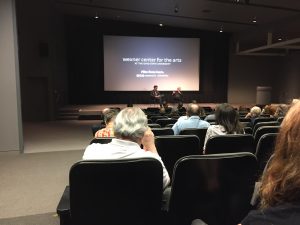 The other thing that Cartooning from the Deep End reiterated for me is that “cheap offense” is the other side of “cheap laugh” coin. It’s really not difficult to offend people, just as it’s really not difficult to make people laugh. That’s why satirists of all kinds who lazily rely on hackneyed bigoted tropes will always outnumber those who strive to say something revealing and thought-provoking. As author John Scalzi famously noted, the failure mode of “clever” is “asshole.”
The other thing that Cartooning from the Deep End reiterated for me is that “cheap offense” is the other side of “cheap laugh” coin. It’s really not difficult to offend people, just as it’s really not difficult to make people laugh. That’s why satirists of all kinds who lazily rely on hackneyed bigoted tropes will always outnumber those who strive to say something revealing and thought-provoking. As author John Scalzi famously noted, the failure mode of “clever” is “asshole.”
Let me repeat that– it’s the job of editorial cartoonists to mock, satirize, ruthlessly parody, and otherwise ridicule powerful people. Barry Deutsch, political cartoonist and sometimes mentor to me, says on his Patreon page:
I’m pissed off. I’m pissed off about so many things– about homophobia, about sexism, about racism, about transphobia…the list goes on and on. And when I get pissed off, I draw political cartoons.
Dwayne “Mr. Fish” Booth told the audience at his film screening:
I start with outrage and then I render what that outrage looks like.
My own Patreon page says:
And then the election happened, and I found myself furious. I went through the stages of grief, hit “anger,” and held onto that one while proceeding through the rest. I wanted to find a productive way to express that anger, and to play out the conversations that were going on in my head in case they resonated with anybody else.
So of necessity, the history of political cartooning in America– really, anywhere– is a history of artists speaking truth to power in cartoon form because injustice pisses a political cartoonist off, and the cartoon is their counter-argument. Their counterpoint, if you will. In retrospect, I realize that this is why Dr. Robert Russell called us canaries in a coalmine. This is why he called us magical people, filled with righteous indignation.
Phew. That’s some heady stuff, isn’t it? With great magic comes great responsibility, after all.
Responsibility carried faithfully by The Nib over the years, for which editor Matt Bors was recognized at a reception in the museum following our tour. The CXC gave him the Transformative Work Award, and Nib contributor Chelsea Saunders received the AAEC’s Locher Award for outstanding young cartoonists. I briefly met Bors and Matt Lubchansky at the reception and asked what was obviously the most important question of the evening– whether Bors had been forced to give up the Ignatz Award brick given to The Nib in mid-September for outstanding achievements in cartooning by small press creators. Bors had tweeted that he was challenged about it at the airport (which does kind of make sense– it’s a brick, after all) and not allowed to bring it with him onto the plane. Fortunately, as he told me at the reception, he was allowed to stow it in his checked bag, so the prestigious award was not, in fact, forcibly abandoned.
On Day 3 I rushed back to the Metropolitan Museum in the morning to complete my Chalk Slam drawing on the sidewalk, only to discover that the rain overnight had caused everything to fade considerably. It was poor planning on my part all around– I’d intended to contribute to the free speech-themed AAEC collection by drawing my friend, comedian Keith Lowell Jensen, accompanied by text from one of his performances:
In junior high I took band. The teacher was upset when I wouldn’t say the pledge of allegiance. He made a heartfelt speech about his visit to East Germany (which used to be a thing) and how sad and oppressive it was on that side of the wall, how they lacked the freedoms that I took for granted. I asked him “On what side of that wall do you think they’re more likely to force children to pledge their allegiance?” And that is the story of why I don’t know how to play the clarinet.
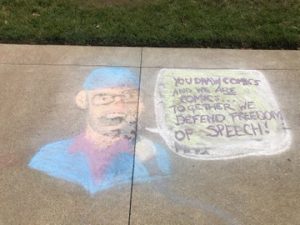 If you’ve done any sort of chalk drawing recently, you will immediate grasp the flaw in my plan– however hilariously apt for the occasion, that message is way too long. I managed to draw Keith and write the first part of the quote on the first day, but on the second day erased the text and replaced it with a much simpler (but hopefully still worthy) message. My apologies, Keith!
If you’ve done any sort of chalk drawing recently, you will immediate grasp the flaw in my plan– however hilariously apt for the occasion, that message is way too long. I managed to draw Keith and write the first part of the quote on the first day, but on the second day erased the text and replaced it with a much simpler (but hopefully still worthy) message. My apologies, Keith!
Inside the library, the AAEC meeting that morning began with nominations for office within the organization, which was followed by presentations by Middle Eastern cartoonists invited to the meeting. Unfortunately I had to duck out of the room early, as these presentations were just beginning, because I was scheduled to be among the first group to man the AAEC tables at the CXC vendor floor, but again I will link you to the CSOTD blog where you can read about these visiting cartoonists and see some of their work.
I’d never been to a comic con of any kind before, so the vendor floor of CXC took me by surprise– it seemed huge. I didn’t have anything to sell, but at the last minute managed to get some prints of four of my cartoons and brought them along with me to give away. Seated on my left was Mike Thompson of the Detroit Free Press, expertly inking a cartoon at the table, and on my right was Nancy Ohanion, selling prints of her beautiful “cut paper” style caricatures. Since I’d been silent during the business meeting on Day 2 and absent for much of it on Day 3, I took this opportunity to seek out Kevin Siers and give some suggestions on how the AAEC should find new, younger members. Those fell under three general categories:

Feedback and discussion: Starting out as a cartoonist is rough. All you have to go on are what you’ve seen from existing cartoonists, and it isn’t always obvious why they made the choices they made, and whether/when you should emulate them or try to strike a new path. So I suggested some kind of internal feedback mechanism on the new (sometime in the next couple of weeks) AAEC website, enabling cartoonists to comment on each other’s work and also see the existing comments for that work, allowing for a discussion. Kevin broached the idea of a private Facebook group for AAEC members instead or in addition to the commenting mechanism, which I enthusiastically supported. Community in some form or another is absolutely essential.
Publication: Given the state of print media, but also given the subject matter that young political cartoonists want to comment on, there is no real expectation of someday becoming a newspaper editorial cartoonist. To interest new members, the AAEC should suggest career paths outside of traditional print media. This is an excellent opportunity to name and praise alternative print and online media sources who do solicit and publish political cartoons.
Experimentation: Perhaps the AAEC could even create its own publication, similar to how comedians have certain clubs where they try out their new bits, and feel comfortable pushing the boundaries a little. For cartoonists, this would be a site where they’d have the freedom to be edgy, try out cartoons that mainstream publishers might not want to risk taking responsibility for themselves, but could view a cartoonist’s existing portfolio, both the stuff in the edgy category and otherwise, to have something to go on when considering whether to work with that cartoonist on future projects. I mentioned that as a blogger it can be difficult to pull people to your site on a regular basis, but group blogs with multiple bloggers tend to be much more successful in that regard, and an informal “alternative” group cartoonists blog might be something with considerable appeal.
I spent so long at the AAEC tables that I missed Kevin “Kal” Kallaugher’s presentation, which was disappointing because over the last couple of years I’ve fallen in love with his use of dimension and detail to create wild farcical scenes that make complete sense according to their own logic. Looking at a Kallaugher cartoon is like falling down the rabbit hole into an Alice in Wonderland scene where people have huge heads and expressive faces that look like they’re carved out of wood, and you might find yourself witnessing a court proceeding, assembly line, or pirate ship battle that analogizes real life but is equally a product of Kal’s ever-fertile imagination. Fortunately I did manage to speak with Kal later on at the AAEC reception (the one described completely non-chronologically at the beginning of this post).
There was, however, time to both peruse the CXC vendor tables and attend other presentations, so I made a beeline to Nate Powell’s panel discussion after hearing Kevin Siers recommend his three book series March, documenting the civil rights advocacy of Rep. John Lewis. Powell illustrated the graphic novels, and the writing was done by Lewis himself as well as Andrew Aydin.
Wandering around the vendor floor, I also came across a table with a familiar book– Monkey Chef, written and illustrated by Mike Freiheit. I remembered Freiheit from a comic on Steven Pinker that he illustrated for Current Affairs last year. At that time I remember adding Monkey Chef to my list, but wasn’t flush with cash so didn’t buy it. This time I wasn’t any better off, but buying the book in person gave me the chance to talk with Freiheit a bit as he doodled a charming drawing of a monkey in the front pages of the book for me. The Pinker comic was authored by Lyta Gold, and Mike commented that he actually wasn’t very familiar with Pinker, so I tried to offer a brief summary of how Pinker had been an intellectual hero of mine some years ago, but unfortunately he suffered from that tendency of American public intellectuals to hold forth on issues well beyond his actual area of expertise, which as it happens was the subject of the comic that Mike had illustrated (If I’d read Anand Giridharadas’s book Winners Take All: The Elite Charade of Changing the World, I might’ve been able to offer an even better take, but again– on the list).
